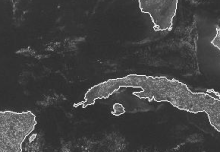Convergence zone

A convergence zone in meteorology is a region in the atmosphere where two prevailing flows meet and interact, usually resulting in distinctive weather conditions.[1] This create a mass accumulation that eventually leads to a vertical movement and the formation of clouds and precipitation.[1] Large scale convergence, called synoptic scale convergence, provides weather systems such as baroclinic troughs , low-pressure areas and cyclones . Small scale convergence will give from isolated cumulus clouds to large areas of thunderstorms. The inverse of the convergence is the divergence.
Large scale
An example of a convergence zone is the Intertropical Convergence Zone (ITCZ), a low pressure area which girdles the Earth at the Equator. Another example is the South Pacific convergence zone that extends from the western Pacific Ocean toward French Polynesia.
Mesoscale
Convergence zones also occur at a smaller scale. Some examples are the Puget Sound Convergence Zone which occurs in the Puget Sound region in the U.S. state of Washington; Mohawk–Hudson convergence in the U.S. state of New York; the Brown Willy effect which can be generated when south-westerly winds blow over Bodmin Moor in Cornwall; and the Pembrokeshire Dangler which can form when northerly winds blow down the Irish Sea. They can also be associated with sea breeze fronts.
References
- ^ a b LEUNG Wai-hung (June 2010). "Meteorology Basics: Convergence and Divergence". Hong Kong Observatory. Retrieved November 25, 2015.
